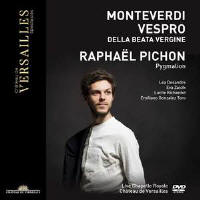Texte paru dans: / Appeared in: |
|
|
Outil de traduction (Très approximatif) |
|
|
Reviewer:
J. F. Weber The masterpiece of 1610 is sung and played in concert format in the sanctuary of the royal chapel of Versailles. The cameras are trained on close-ups of the personnel most of the time, with overall views of the ensemble occasionally, but no attempt to let the gaze wander around the chapel. At appropriate times, solo singers are placed away from the group or in the gallery above for effect. The performance is large-scale, with 36 choral singers and 24 players on period instruments. Additional elements of the performance include antiphons for second Vespers of the Assumption before the psalms and the antiphon for the same first Vespers before the canticle. Monteverdi’s 1627 Sancta Maria succurre miseris precedes the Sancta Maria (Gabriel Garrido used it as the antiphon after the Magnificat in his recording). A capitulum (In omnibus requiem quaesivi) is chanted before the hymn, and the three usual closing versicles are sung rather elaborately after the Magnificat. None of this is mentioned in the booklet, which refers to a “litany of the saints” which does not occur as stated with the Sancta Maria movement. The direct comparison is John Eliot Gardiner’s DVD (Fanfare 27:1), originally recorded at San Marco in 1989. As a visual experience, that one was burdened by an attempt to turn the unceremonious prayer of the Office into a liturgical action such as the celebration of the Mass, and the cameras also roamed the basilica for the exquisite sights to behold. It was similar in scope to this performance, even if the chorus and period-instrument players were slightly less numerous, but the acoustics presented a problem for the engineers. Pichon performs in a well-controlled acoustic environment, and he has a splendid group of soloists joining his ensemble, tenor Zachary Wilder standing out for singing the second tenor in Duo Seraphim and the solo in Audi Coelum without the music in hand. For the former work the three tenors are placed with the first two at opposite sides of the ensemble and the third in the gallery, forming a symbolic triangle in the wide angle shot. Lighting ranges effectively from bright to dark, and the soloists in the Magnificat are notably effective. The total time does not imply slow tempos, for the added music accounts for normal tempos. There are many audio recordings in a bewildering array of interpretations, but this is one of the few videos. (The BBC documentary DVD, 39:4, that I missed did not show the Vespers.) Unless you want something like one voice to a part, this will be an enjoyable experience. |
|




